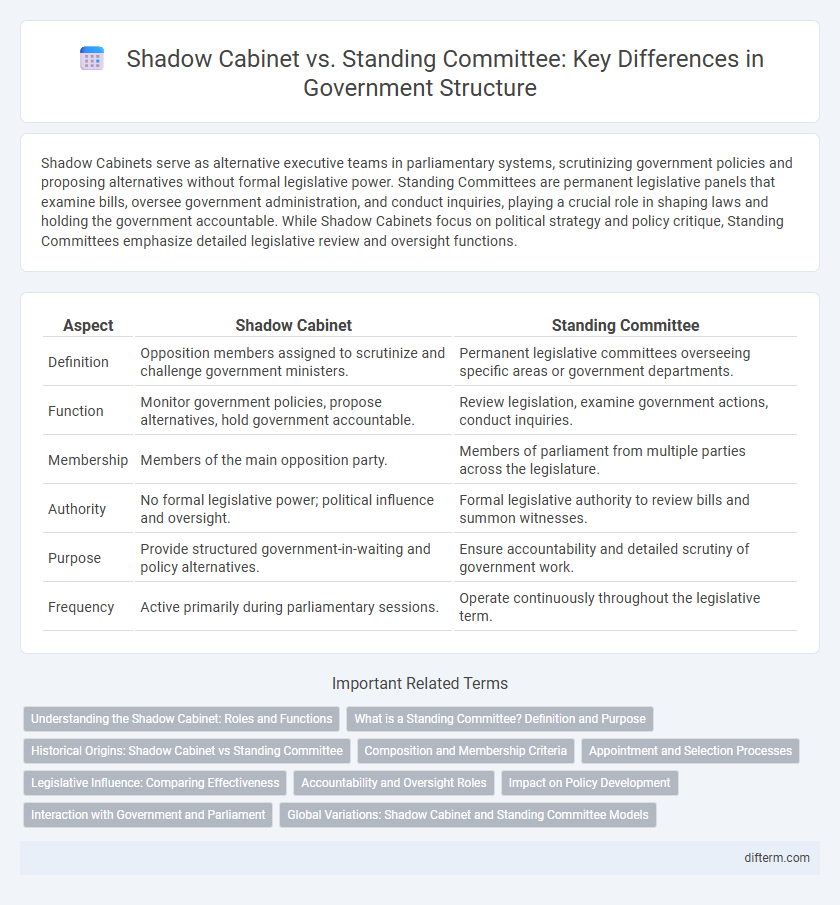Shadow Cabinets serve as alternative executive teams in parliamentary systems, scrutinizing government policies and proposing alternatives without formal legislative power. Standing Committees are permanent legislative panels that examine bills, oversee government administration, and conduct inquiries, playing a crucial role in shaping laws and holding the government accountable. While Shadow Cabinets focus on political strategy and policy critique, Standing Committees emphasize detailed legislative review and oversight functions.
Table of Comparison
| Aspect | Shadow Cabinet | Standing Committee |
|---|---|---|
| Definition | Opposition members assigned to scrutinize and challenge government ministers. | Permanent legislative committees overseeing specific areas or government departments. |
| Function | Monitor government policies, propose alternatives, hold government accountable. | Review legislation, examine government actions, conduct inquiries. |
| Membership | Members of the main opposition party. | Members of parliament from multiple parties across the legislature. |
| Authority | No formal legislative power; political influence and oversight. | Formal legislative authority to review bills and summon witnesses. |
| Purpose | Provide structured government-in-waiting and policy alternatives. | Ensure accountability and detailed scrutiny of government work. |
| Frequency | Active primarily during parliamentary sessions. | Operate continuously throughout the legislative term. |
Understanding the Shadow Cabinet: Roles and Functions
The Shadow Cabinet consists of opposition party members who scrutinize government policies and propose alternatives, acting as a government-in-waiting. Members of the Shadow Cabinet are assigned specific portfolios that correspond to current government ministries, enabling them to hold ministers accountable and prepare for potential leadership roles. Their primary functions include policy critique, offering alternative solutions, and enhancing democratic transparency.
What is a Standing Committee? Definition and Purpose
A Standing Committee is a permanent legislative body established to oversee specific areas of government policy, administration, and legislation. It ensures detailed examination, debate, and scrutiny of bills, government actions, and public issues within its jurisdiction. Standing Committees play a critical role in enhancing transparency, accountability, and informed decision-making in government operations.
Historical Origins: Shadow Cabinet vs Standing Committee
The Shadow Cabinet originated in the United Kingdom during the 19th century as a mechanism for the opposition party to scrutinize and challenge the sitting government, providing alternative policies and leadership. Standing Committees trace their roots to parliamentary practices in the 17th century, evolving as permanent groups within legislatures designed to oversee specific areas of policy, legislation, and administration. Both institutions have become fundamental in democratic governance, reflecting different approaches to accountability and legislative oversight.
Composition and Membership Criteria
The Shadow Cabinet consists of senior members of the opposition party appointed to mirror each government minister, typically selected based on expertise and parliamentary experience to scrutinize government policies effectively. Standing Committees are permanent, bipartisan bodies comprising members from all parties proportional to their representation in the legislature, chosen for their specialized knowledge or interest in specific policy areas. Membership in the Shadow Cabinet is exclusive and strategic for political leadership roles, whereas Standing Committees prioritize balanced representation and technical competence for legislative review and oversight.
Appointment and Selection Processes
The Shadow Cabinet is typically appointed by the leader of the opposition party, selecting members from their party ranks to mirror the official Cabinet. Standing Committees are established through parliamentary procedures, with members often elected by the legislature or appointed based on party representation and expertise. While the Shadow Cabinet's formation hinges on political leadership decisions, Standing Committee membership involves formal legislative processes ensuring accountability and balanced oversight.
Legislative Influence: Comparing Effectiveness
Standing Committees possess direct legislative influence by scrutinizing bills, conducting hearings, and recommending amendments, significantly shaping policy outcomes. Shadow Cabinets hold indirect influence through public criticism and proposing alternative policies, impacting legislation primarily via political pressure and public opinion. Empirical evidence shows Standing Committees often achieve more tangible legislative changes, while Shadow Cabinets enhance democratic accountability by providing opposition oversight.
Accountability and Oversight Roles
The Shadow Cabinet plays a crucial accountability role by scrutinizing government policies and proposing alternatives, acting as a government-in-waiting to ensure transparency and responsiveness. Standing Committees provide detailed oversight by examining legislation, budgets, and administration within specific government departments, enabling systematic evaluation and continuous monitoring. Both mechanisms strengthen democratic governance by demanding government accountability and fostering informed policy debates.
Impact on Policy Development
Shadow Cabinets provide alternative policy proposals and scrutinize government actions, enhancing policy diversity and accountability. Standing Committees conduct detailed examinations of legislation and government operations, directly influencing policy formulation through expert recommendations. Their combined roles ensure robust debate and informed decision-making within the legislative process.
Interaction with Government and Parliament
Shadow Cabinets scrutinize government policies and propose alternatives, acting as the opposition's executive team to hold the government accountable. Standing Committees consist of parliamentary members who examine legislation, oversee government operations, and facilitate detailed discussions on policy implementation. Interaction with Parliament occurs through reports and recommendations from Standing Committees, while Shadow Cabinet members actively challenge government actions during debates and question periods.
Global Variations: Shadow Cabinet and Standing Committee Models
Shadow Cabinets, prominently used in parliamentary systems such as the United Kingdom, Canada, and Australia, function as official opposition bodies mirroring government ministries to provide alternative policies and hold the government accountable. Standing Committees, prevalent in legislative bodies worldwide including the United States Congress and the European Parliament, operate as permanent committees focusing on specific policy areas, overseeing government operations, and scrutinizing legislation. Variations in the structure and powers of Shadow Cabinets and Standing Committees reflect different political traditions and institutional designs, influencing their roles in policy-making, oversight, and democratic governance globally.
Shadow Cabinet vs Standing Committee Infographic

 difterm.com
difterm.com